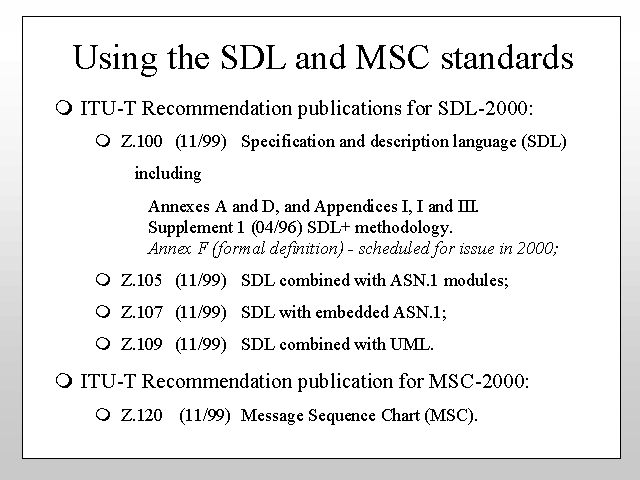Slide 5 of 14
Notes:
The International Telecommunication Union - Telecommunications standards sector (ITU-T) is the publisher of the SDL and MSC standards. The reason that ITU-T standards are called “Recommendations” is their international legal status: the ITU recommends standards to be applied by national bodies in the telecommunication industry both for equipment supply and operation.
Occasionally it may be necessary to use the standards to understand exactly why what has been written is either unacceptable to a tool or behaves in an unexpected way.
The main standard for SDL is Z.100. This gives a definition of SDL in a precise and concise way, and therefore is a language reference manual and is not suitable for learning the language. Z.100 is sometimes difficult to understand and (for reasons of resources) the current edition does not contain examples. However, it has a good index to navigate around the syntax rules: both the definitions and uses are listed.
The concrete syntax rules are defined in BNF and the dialect of BNF is defined in Z.100. For each topic textual grammar is given before graphical (SDL/GR specific) grammar. These are both preceded (where relevant) by the abstract grammar that defines (in MetaIV) the structure of the elements of the formal language model. The formal semantics (to be completed in 2000) formally links the concrete syntax to the abstract syntax and to an operational model in ASM. Each grammar includes syntax and rules (such as when an item is or is not allowed) that are not convenient to define syntactically.
Annex F (the formal semantics) is equivalent (if there are no errors in Z.100) to the Semantic description and Models given in the main text of Z.100 in natural language.
Z.105 extends Z.100 to allow ASN.1 modules to be linked to SDL, so that ASN.1 data types can be used directly in SDL. Z.105 defines the mapping of ASN.1 to SDL.
Z.107 extends Z.100 and Z.105 so that ASN.1 data types can be used defined in-line in SDL. This is a separate standard to Z.105 because some organisations (in particular ETSI) do not want ASN.1 embedded in SDL. GEODE and Cinderella support Z.107, but SDT does not (at the time of writing).
Z.109 defines SDL as a UML profile, giving the mapping of UML concepts.
Z.120 is similar to Z.100, but for MSC. The formal model uses a different formalism.

